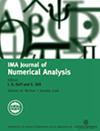时间分数卡恩-希利亚德模型的变步分数 BDF2 方案的渐近兼容能量
IF 2.3
2区 数学
Q1 MATHEMATICS, APPLIED
引用次数: 0
摘要
通过局部-非局部拆分技术构建了近似于阶数为 $\alpha \in (0,1)$ 的 Caputo 分导数的变步长分式 BDF2 公式的新型离散梯度结构,即将分式 BDF2 公式拆分为类似于一阶导数的两步反向微分公式(BDF2)的局部部分和类似于 Caputo 导数的 L1 型公式的非局部部分。然后在弱步长比约束$0下建立了时间分式Cahn-Hilliard模型的变步长分式BDF2隐式方案的局部离散能量耗散规律。3960\le \tau _{k}/\tau _{k-1}<r^{*}(\alpha )$,其中$\tau _{k}$ 是第k$个时间步长,$r^{*}(\alpha )\ge 4.660$ for $\alpha \ in (0,1)$.本结果为[SINUM, 57: 218-237, Remark 6]中的开放问题提供了一个实际答案,并大大放宽了严格的步长比限制[Math.]更有趣的是,离散能量和相应的能量耗散规律分别与经典 Cahn-Hilliard 方程的变步长 BDF2 方法的相关离散能量和能量耗散规律渐近兼容。据我们所知,这种类型的能量耗散规律是首次针对卡普托导数的变步长 L2 型公式建立的。为了证明我们提出的方法的准确性和有效性,我们提供了带有自适应步进程序的数值示例。本文章由计算机程序翻译,如有差异,请以英文原文为准。
Asymptotically compatible energy of variable-step fractional BDF2 scheme for the time-fractional Cahn–Hilliard model
A novel discrete gradient structure of the variable-step fractional BDF2 formula approximating the Caputo fractional derivative of order $\alpha \in (0,1)$ is constructed by a local-nonlocal splitting technique, that is, the fractional BDF2 formula is split into a local part analogue to the two-step backward differentiation formula (BDF2) of the first derivative and a nonlocal part analogue to the L1-type formula of the Caputo derivative. Then a local discrete energy dissipation law of the variable-step fractional BDF2 implicit scheme is established for the time-fractional Cahn–Hilliard model under a weak step-ratio constraint $0.3960\le \tau _{k}/\tau _{k-1}<r^{*}(\alpha )$, where $\tau _{k}$ is the $k$th time-step size and $r^{*}(\alpha )\ge 4.660$ for $\alpha \in (0,1)$. The present result provides a practical answer to the open problem in [SINUM, 57: 218-237, Remark 6] and significantly relaxes the severe step-ratio restriction [Math. Comp., 90: 19–40, Theorem 3.2]. More interestingly, the discrete energy and the corresponding energy dissipation law are asymptotically compatible with the associated discrete energy and the energy dissipation law of the variable-step BDF2 method for the classical Cahn–Hilliard equation, respectively. To the best of our knowledge, such type energy dissipation law is established at the first time for the variable-step L2 type formula of Caputo’s derivative. Numerical examples with an adaptive stepping procedure are provided to demonstrate the accuracy and the effectiveness of our proposed method.
求助全文
通过发布文献求助,成功后即可免费获取论文全文。
去求助
来源期刊
CiteScore
5.30
自引率
4.80%
发文量
79
审稿时长
6-12 weeks
期刊介绍:
The IMA Journal of Numerical Analysis (IMAJNA) publishes original contributions to all fields of numerical analysis; articles will be accepted which treat the theory, development or use of practical algorithms and interactions between these aspects. Occasional survey articles are also published.

 求助内容:
求助内容: 应助结果提醒方式:
应助结果提醒方式:


